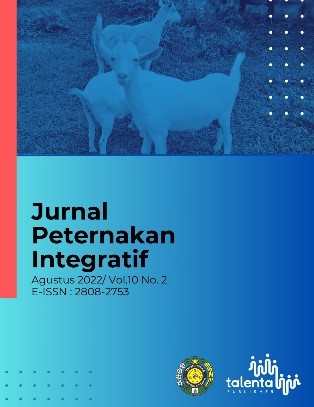Maggot Production in Various Organic Wastes (Vegetables, Fruits, Food Processing Industries): Potential as Alternative Feed Substitutes for Fish Meal
DOI:
https://doi.org/10.32734/jpi.v10i2.9231Keywords:
fermentation, maggot production, maggot, nutritional quality organic wasteAbstract
Maggot is an alternative to fish meal because it has a fairly high protein content, is easy to cultivate and is able to decompose organic waste into its own food. The better the quality of the maggot growing media, the higher the maggot production will be . Vegetable, fruit and food processing industrial waste is an organic waste that is commonly encountered but its nutritional quality is low. To improve the nutritional quality, fermentation was carried out using local microorganisms (MOL). The purpose of this study was to examine the effect of various types of vegetable, fruit and food processing industrial waste media and different fermentation times on the production of maggot (Hermetia illucens). This study was conducted experimentally using factorial randomized block design (RAK) method with 2 factors ( 3×3), namely factor 1 for various organic wastes (D1 = vegetable waste, D2 = fruit waste, D3 = food processing industrial waste) and factor 2 for fermentation time (L1 = 2 days, L2 = 4 days, L3 = 6 days), with 3 replicates. The parameters of this study consisted of biomass weight, feed consumption, waste reduction index/WRI, feed conversion efficiency/ECI, and survival rate/SR. The results of variance showed that organic waste and fermentation time had a very significant effect (p<0.01) on the parameters of maggot production. It was concluded that the production of maggot (Hermetia illucens) was best in the D1L1 treatment with a biomass weight of 1522.33 g, feed consumption 66.06%, WRI 2.20%, ECI 0.42%, and SR 89.52%.
Downloads
Downloads
Published
Issue
Section
License
Copyright (c) 2022 Jurnal Peternakan Integratif

This work is licensed under a Creative Commons Attribution-ShareAlike 4.0 International License.
The Authors submitting a manuscript do so on the understanding that if accepted for publication, copyright of the article shall be assigned to Jurnal Peternakan Integratif as well as TALENTA Publisher Universitas Sumatera Utara as the publisher of the journal.
Copyright encompasses exclusive rights to reproduce and deliver the article in all forms and media. The reproduction of any part of this journal, its storage in databases and its transmission by any form or media, will be allowed only with written permission from Jurnal Peternakan Integratif.
The Copyright Transfer Form can be downloaded here.
The copyright form should be signed originally and sent to the Editorial Office in the form of original mail or scanned document.















